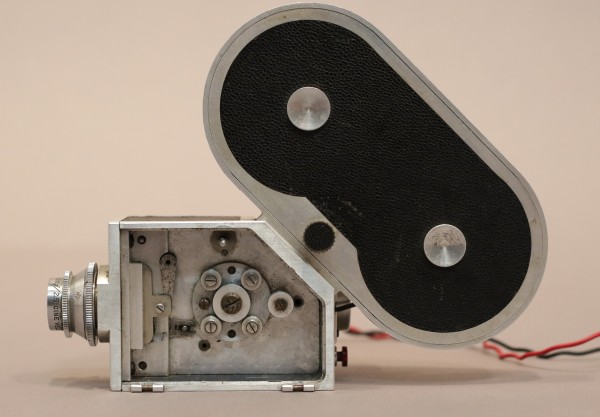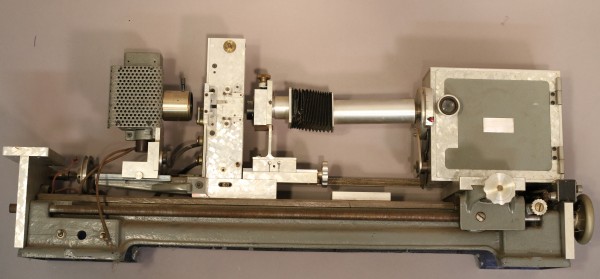Film Explorer

Small strip of 3mm test film.
Eric Berndt Collection, USC HMH Foundation Moving Image Archive, Los Angeles, CA, United States.

Detail highlighting placement of magnetic stripe.
Eric Berndt Collection, USC HMH Foundation Moving Image Archive, Los Angeles, CA, United States.
Identification
History
Eric Max Berndt was born in Berlin, Germany, on October 31, 1903. In 1922, having already developed various film technologies for Siemens, the precociously talented Berndt emigrated to the United States where he swiftly found employment in New York City as a camera repairman, while designing film printers for the Kislyn Color Corp. Eventually he began overseeing the technical aspects of production for the Duplex Motion Picture Company based in Delaware.
In 1932, he formed the Eric M. Berndt Company to produce the Berndt-Maurer 16mm sound-on-film camera, which was widely used in the newsreel industry. With his partner John Maurer, he next founded the Berndt-Mauer Corporation in 1935, which manufactured innovative sound cameras and other film equipment.
Berndt moved to the west coast of North America in 1939, subsequently forming the Berndt-Bach Company with Walter Bach. The company began manufacturing the Auricon 16mm camera for use in the emerging television industry. Berndt resigned from the company in 1960 and began developing “a sub-miniaturized motion-picture camera using 3mm film”, which was, according to the Society of Motion Picture and Television Engineers (SMPTE), “used in a special cockpit photography application by the United States Air Force at Edwards Air Force Base.” (Ryan, 1973)
In marketing materials for Berndt’s camera, perforator, printer, and projector package, he described the Cine-System 3 as “the miniaturization of ALL the component parts necessary for a completely integrated electronic and sound-on-film system utilizing a film width of 0.125 mils. (approximating 3mm)”, including “machines to cut and perforate the 3mm film from standard emulsions; a cine-camera weighing (with motor) approximately 12 ozs”, “a daylight processing tank” and “an optical printer for the transfer of the image to 16mm film for projection on any standard 16mm projector.” (Berndt Collection)
Every foot of Cine-System 3 film contained 120 frames. Berndt took 16mm, unperforated film and sliced it so that a 100-ft roll of 16mm film yielded 500 ft of 3mm film. The Cine-System 3 camera ran three times slower than a 16mm camera, so when a 100-ft roll of 16mm film was converted to 3mm stock, it could be used to film the same amount of footage as 1,500 ft of 16mm film – the system’s economy of film stock use was part of Berndt’s pitch for his latest invention. (Berndt, 1972)
Once the 3mm system was prototyped, Berndt sought potential customers who might be drawn to his “proven and dependable means for recording a synchronous electronic audio-visual image in places and on projects where size and weight are a critical factor, and where the need to study and evaluate is a post-operative necessity.” Berndt also touted its versatility: with a lens swap it could produce telephoto or wide-angle images, and it only required a 12-volt battery to power it.
Berndt claimed to have fielded numerous calls from agencies in Washington DC about potential uses for his system, including for a “top secret” application that concealed a 3mm camera in eyeglasses or a cigarette lighter. Berndt had another serious inquiry about his system from a bank for surveillance purposes, a use which proved unviable due to its low resolution (Berndt, 1972). Berndt believed that his system could best be used for cost-effective information storage and retrieval, especially in confined spaces, which is why it seemed to have potential for NASA.
At some point Berndt gave up on the system, whose prototype now resides in the University of Southern California’s Moving Image Archive. Berndt died in 1975 at age 72.

3mm camera with 100-ft magazine.
Eric Berndt Collection, USC HMH Foundation Moving Image Archive, Los Angeles, CA, United States.

Alternate design 3mm camera, with internal 100-ft reels.
Eric Berndt Collection, USC HMH Foundation Moving Image Archive, Los Angeles, CA, United States.

Slitter used to cut 16mm raw stock into five usable reels of 3mm.
Eric Berndt Collection, USC HMH Foundation Moving Image Archive, Los Angeles, CA, United States.
Selected Filmography
This reel is the only surviving 3mm footage and is conserved at the USC HMH Foundation Moving Image Archive in Los Angeles.
This reel is the only surviving 3mm footage and is conserved at the USC HMH Foundation Moving Image Archive in Los Angeles.
Technology
The Cine-System 3 appears to have been designed largely for use by NASA for whom the most notable benefit would have been its extremely small size. The camera, which is around four inches long and weighs a mere twelve ounces, could have been mounted in view of instrumentation panels to capture the activity of an entire flight on multiple reels that would take up very little physical space within the spacecraft. Berndt devised a 3–16mm optical printer so that the complete reels of 3mm could be blown up to 16mm, to allow for easier, more convenient viewing of the captured footage. In addition to the printer, there were two different cameras produced; some processing equipment; a perforator and slitter designed to reduce 16mm down to reels of 3mm; a small rewind apparatus; multiple metal reels and a modified Bell & Howell 8mm projector. No evidence of any 16mm blow-ups has been located. Having experienced first-hand the difficulties associated with working with the film in its 3mm state, we assume that Berndt intended all reels be blown up to the standardized 16mm. This would suggest that the modified projector was used solely as a test item, perhaps to demonstrate the quality of the original. Although Berndt referred to it as a sound-on-film system, there is no surviving sound equipment and the extant test film is silent; he may have striped the film as proof of concept since the 3mm projector he modified was a silent projector and the two surviving cameras have no sound attachment.
The general quality of the footage captured on the 3mm film reels rivaled that of 8mm. Utilizing a similar emulsion area as 9.5mm film with the center perforation, allowed 3mm to maximize the bulk of its small frame for the image. The device’s failure in the marketplace seems to have derived primarily from three issues. First, was that its extremely small size actually made it very difficult to work with. This would limit the number of potential users to only those with extensive film-handling expertise. Second, was that although the image quality was quite good considering its size, it was not nearly good enough to convey the kind of detail NASA and other potential users would have found most useful in the long run. Third, it was developed around the same time that videotape was becoming more commonplace and NASA opted for the simplicity of the latter, leaving Berndt’s “microfilm” out in the cold.
References
Berndt, Eric (1972). “William C. Flaherty oral history with Berndt”, October 22, 1971–March 31, 1972, American Film Institute Louis B. Mayer Oral History Collection, Los Angeles, CA, United States.
Berndt, Eric (n.d.). Eric Berndt Collection files, Motion Picture History Book List. USC HMH Foundation Moving Image Archive, Los Angeles, CA, United States. https://www.uschefnerarchive.com/project/motion-picture-history-book-list/
Everett, Dino and Marsha Gordon (2016). “3mm, the Smallest Gauge”. The Moving Image, 16:2 (Fall): pp. 1–20.
Fanucci, Kenneth (1968). “He Designs and Collects Cameras but Skips Movies”. Los Angeles Times, May 5.
Ryan, Roderick T. (1973). “Eric M. Berndt”. Journal of the Society of Motion Picture and Television Engineers, 82:2: p. 98.
SMPTE (1974). “Awards Presentation 1974”. Journal of the Society of Motion Picture and Television Engineers, 83:12: pp. 968–972.
Patents
None found.
Compare
Related entries
Authors
Dino Everett is the HMH Foundation Archivist at University of Southern California’s Moving Image Archive.
Marsha Gordon is Professor of Film Studies at North Carolina State University.
Herb Farmer
Everett, Dino & Marsha Gordon (2024). “Cine-System 3”. In James Layton (ed.), Film Atlas. www.filmatlas.com. Brussels: International Federation of Film Archives / Rochester, NY: George Eastman Museum.



